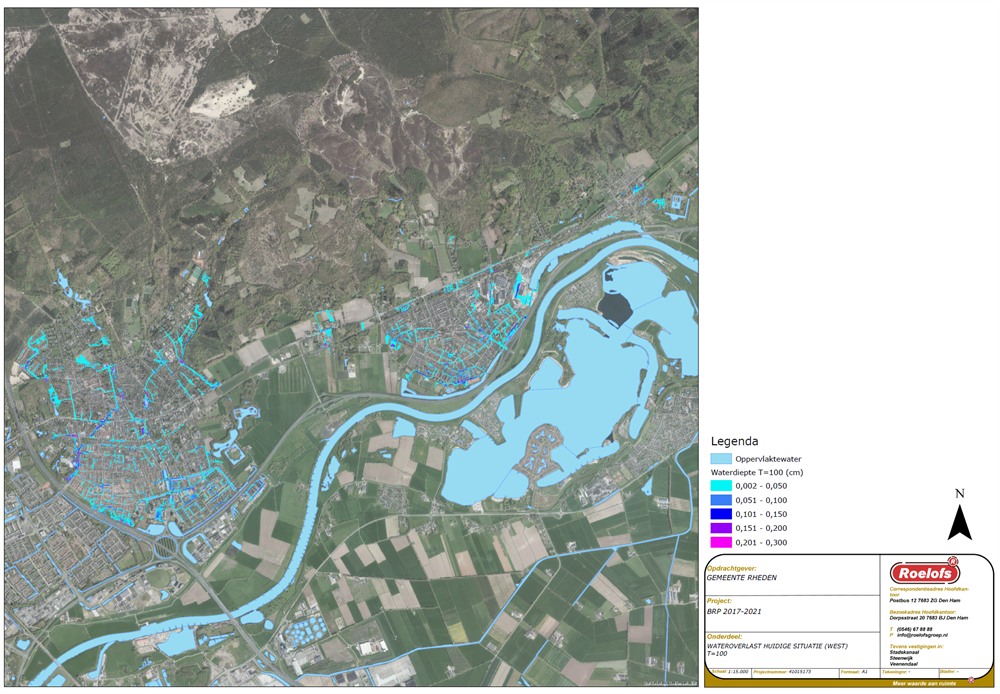Waterlogging stress test in municipality of Rheden
Within the context of a new basic sewerage plan, the municipality of Rheden has commissioned a waterlogging stress test. The stress test is intended to map out the risk of waterlogging and provide insight into effective measures.
With respect to mapping out the risk of waterlogging, the municipality has opted for a risk-based approach. Risk-based management involves choices/measures being based on the potential impact of waterlogging. To this end, various (extreme) precipitation events have been calculated and their impact on vulnerable functions has been analysed for each waterlogging location.
Structure of the stress test
For this stress test, the municipal 1D sewer model has been expanded with a 2D surface level model. The municipality is situated in a sloping area. Consequently, calculations based on a combination of a sewer model and a surface level model provide considerable added value. For the purpose of the stress test, the models have been calculated in a fully integrated manner in the lnfoworks ICM calculation program.
Various extreme precipitation events have been calculated for the analysis. Downpours have been calculated with repeat times ranging from T=1 to T =100. Subsequently, the impact of waterlogging on various vulnerable functions (tunnels, through roads, buildings, shopping centres, railway stations, et cetera) has been analysed for each downpour. Thus, the risk of waterlogging has been determined for each location (risk = probability x impact).
 Image: Results of the T=100 downpour analysis
Image: Results of the T=100 downpour analysis
Various options for measures have been calculated for the locations running the highest risks. For each measure, the residual risk has also been mapped out. The residual risk shows the risk that remains after a measure has been implemented. Subsequently, the most efficient measure has been determined for each individual location, based on the costs involved and the risk reduction.
Main outcomes of the stress test
The calculations based on the new 2D model involve fewer waterlogging locations compared to the outcomes of the 1D sewer model that was originally used. This can be attributed to the fact that in practice, several locations feature surface-level run-off to greenery or surface water. For the locations at which considerable waterlogging was already calculated, the 2D model has calculated an increase in the extent of waterlogging. This pertains particularly to locations situated on the interface between sloping to flatter areas.
Video: Animation of the waterlogging stress test in Rheden
Furthermore, the 2D surface level model offers tools for the elaboration of measures. Measures can be added to the model to adapt the surface level. The 2D model thus enables “optimisation” of the surface level, by directing water to locations at which it will not cause damage. Measures can range from surface level adaptation and the construction or removal of, e.g., speed bumps to the construction of additional water storage facilities or the expansion of the surface-level or sewer system discharge capacity.
The risk-based approach has helped the municipality to prioritise measures, to determine and substantiate the most efficient measures, and to schedule the measures in the municipal sewerage plan. In addition, the municipality has gained insight into the maximum waterlogging possible during extreme precipitation. Among other things, this generates input for the elaboration of a more general view regarding the design of public space, the adaptation to climate change, and the disconnection strategy.
Some of the measures that have already been scheduled:
- Construction of gutters and ditches to drain water to surface water (thus preventing water from inundating roads);
- Construction of additional sewers underneath railway tracks (additional discharge capacity towards overflow);
- Construction of vertical infiltration wells and wadis;
- Raising or lowering of surface level;
- Above-ground water storage in green spaces;
- Disconnecting pavements from sewer system.
Lesson learned from the project
A risk-based approach to the waterlogging stress test provides efficient tools for the prioritising and elaboration of measures. In addition, it provides a good picture of the maximum waterlogging that may occur.
Contact person
Erik Dekker
Roelofs Advies en Ontwerp
06 13796438
e.dekker@roelofsgroep.nl
